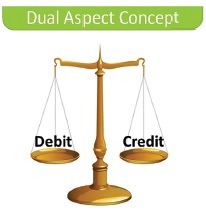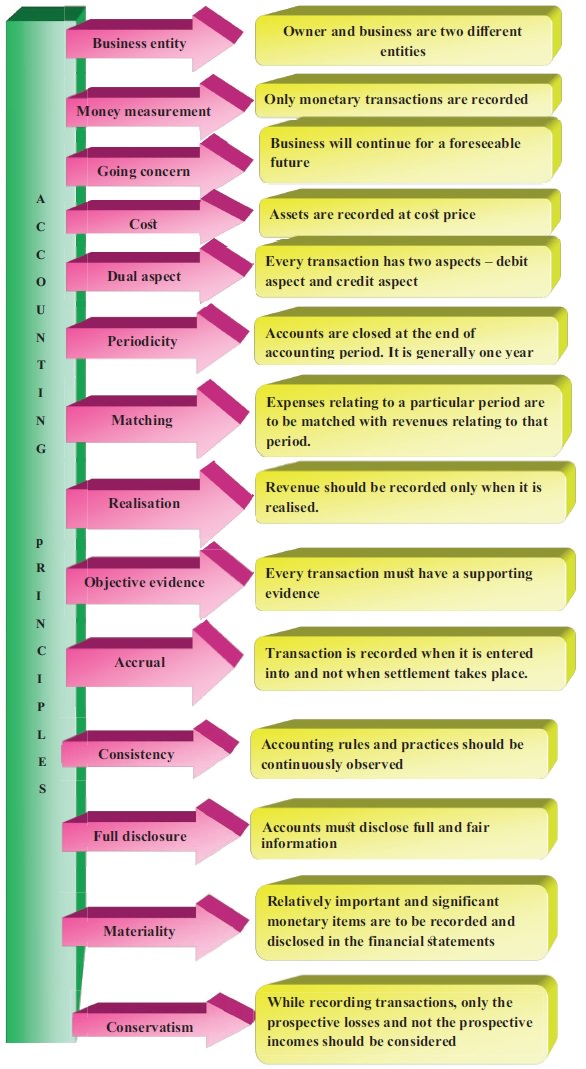Accountancy - Accounting Principles | 11th Accountancy : Chapter 2 : Conceptual Framework of Accounting
Chapter: 11th Accountancy : Chapter 2 : Conceptual Framework of Accounting
Accounting Principles
Accounting Principles
Accounting
principles are the basic norms and assumptions developed and established as the
basis for accounting system. These principles are adopted by the accountants
universally. These accounting principles provide uniformity and consistency in
the accounting methods and process. Such accounting principles are known as
Generally Accepted Accounting Principles (GAAP).
Accounting
principles provide the basic framework within which the accounting records and
accounting reports are to be prepared. Accounting standards have been issued by
national and international regulatory authorities to ensure uniformity of
accounting procedure and accounting results. These accounting standards and
GAAPs provide the theoretical base of accounting. Accounting principles may be
accounting concepts or accounting conventions. Accounting concepts are the
basic assumptions whereas conventions are the guidelines based upon practice or
usage.
Accounting
concepts are the basic assumptions or conditions upon which accounting has been
laid. Accounting concepts are the results of broad consensus. The word concept
means a notion or abstraction which is generally accepted. Accounting concepts
provide unifying structure to the accounting process and accounting reports.
The word
convention refers to traditions or usage. The accounting conventions are the
usage or practices which are followed as a guide to the preparation of
accounting statements.
The utility
of these accounting conventions have been recognised by regulatory authorities
of accountancy in making financial statements more realistic, reliable, and
useful to all concerned parties.
The important
accounting concepts and conventions are discussed below:
(i) Business entity concept
This concept
implies that a business unit is separate and distinct from the owner or owners,
that is, the persons who supply capital to it.
Based on this
concept, accounts are prepared from the point of view of the business and not
from the owner’s point of view. Hence, the business is liable to the owner for
the capital contributed by him/her.
According to
this concept, only business transactions are recorded in the books of accounts.
Personal transactions of the owners are not recorded. But, their transactions
with the business such as capital contributed to the business or cash withdrawn
from the business for the personal use will be recorded in the books of
accounts. It implies that the business itself owns assets and owes liabilities.
(ii) Money measurement concept
This concept
implies that only those transactions, which can be expressed in terms of money,
are recorded in the accounts. Since, money serves as the medium of exchange transactions
expressed in money are recorded and the ruling currency of a country is the
measuring unit for accounting.
Transactions
which do not involve money will not be recorded in the books of accounts. For
example, working conditions in the work place, strike by employees, efficiency
of the management, etc. will not be recorded in the books, as they cannot be
expressed in terms of money.![]()
It helps in
understanding of the state of affairs of the business as money serves as a
common measure by means of which heterogeneous facts about the business are
recorded. For example, if a business has 5 computers, 2 tables and 3 chairs,
the assets cannot be added to give useful information, unless, they are
expressed in monetary terms Rs.1,00,000 for computers, Rs. 10,000 for tables and Rs. 1,500 for chairs.
(iii) Going concern concept
It is the
basic assumption that business is a going concern and will continue its
operations for a foreseeable future. Going concern concept influences
accounting practices in relation to valuation of assets and liabilities,
depreciation of the fixed assets, treatment of outstanding and prepaid expenses
and accrued and unearned revenues. For example, assets are generally valued at
historical cost. Any increase or decrease in the value of assets in the short
period is ignored.
(iv) Cost concept
An asset is
recorded in the books on the basis of the historical cost, that is, the
acquisition cost. Cost of acquisition will be the base for all further
accounting. It does not mean that the asset will always be shown at cost. It is
recorded at cost at the time of its purchase, but is systematically reduced in
its book value by charging depreciation.
The cost concept has the following limitations:
a. In an inflationary situation, when prices of
commodities increase, valuing the assets at historical cost may not represent
the true position of the business.
b. The results of business units established at
different dates are not comparable if assets are recorded on historical basis.
c.
Assets
which do not have acquisition cost such as human resources are not recognised
under this concept.
(v) Dual aspect concept
According to
this concept, every transaction or event has two aspects, i.e., dual effect.
For example, when Arun starts a business with cash Rs. 5,00,000, on the one hand, the business gets cash of Rs. 5,00,000 and on the other hand, a liability arises, that is, the business has to pay Arun a sum of Rs. 5,00,000.

This is the
concept which recognises the fact that for every debit, there is a corresponding
and equal credit. This is the basis of the entire system of double entry
book-keeping.
From this concept arises the basic accounting
equation, that is,
Capital + Liabilities = Assets
(vi) Periodicity concept
This concept
deals with preparing accounts for a particular period. As the proprietors,
investors, creditors, employees and the government are interested in knowing
the performance of the business unit periodically, it becomes necessary to
select a particular period, normally one year for measuring performance. Hence,
financial statements are prepared after every accounting period and not at the
end of its life.
This concept
helps the business in distribution of income to the owners and comparing and
evaluating performance of different periods.
(vii) Matching concept
According to
this concept, revenues during an accounting period are matched with expenses
incurred during that period to earn the revenue during that period. This
concept is based on accrual concept and periodicity concept. Periodicity
concept fixes the time frame for measuring performance and determining
financial status.
All expenses
paid during the period are not considered, but only the expenses related to the
accounting period are considered.
On the basis
of this concept, adjustments are made for outstanding and prepaid expenses and
accrued and unearned revenues. Also due provisions are made for depreciation of
the fixed assets, bad debt, etc., relating to the accounting period. Thus, it
matches the revenues earned during an accounting period with the expenses
incurred during that period to earn the revenues before sharing any profit or
loss.
(viii) Realisation concept
According to
realisation concept, any change in value of an asset is to be recorded only
when the business realises it. When assets are recorded at historical value,
any change in value is to be accounted only when it realises.
(ix) Objective evidence concept
Objective
evidence concept requires that all accounting transactions recorded should be
based on objective evidence. The objective evidence includes documentary
evidence like cash receipts, invoices, etc. It ensures authenticity, accuracy
and reliability of transactions entered in the books of accounts.
(x) Accrual concept
According to
accrual concept, the effects of the transactions are recognised on mercantile
basis, i.e., when they occur and not when cash is paid or received. Revenue is
recognised when it is earned and expenses are recognised when they are
incurred. All expenses and revenues related to the accounting period are to be
considered irrespective of the fact that whether revenues are received in cash
or not and whether expenses are paid in cash or not. For example, i) Credit
sale is recognised as sale though the amount has not been received immediately.
ii) Rent for the month of March-2018 has not been paid and if the accounting
period is 1.4.2017 to 31.3.2018, it will still be recorded as an expense for
the accounting year 2017-2018 because it had become due.
(xi) Convention of consistency
The consistency
convention implies that the accounting policies must be followed consistently
from one accounting period to another. The results of different years will be
comparable only when same accounting policies are followed from year to year.
For example, if a firm follows the straight line method of charging
depreciation since its purchase or construction, the method should be followed
without any change. However, it does not mean that changes are not possible.Change in accounting policy can be incorporated in
the following circumstances:
a. To comply with the provision of law
b. To comply with accounting standards issued and
c. To reflect true and fair view of state of affairs
of the business.
(xii) Convention of full disclosure
It implies
that the accounts must be prepared honestly and all material information should
be disclosed in the accounting statement. This is important because the
management is different from the owners in most of the organisations.
The disclosure should be full, fair and adequate so
that the users of the financial statements can make correct assessment about
the financial position and performance of the business unit.

(xiii) Convention of materiality
According to
this convention, financial statements should disclose all material items which
might influence the decisions of the users of financial statements. Hence, any
item which is not significant and is not relevant to the users need not be
disclosed in the financial statements.
This
principle is basically an exception to the full disclosure principle. The term
materiality is subjective in nature. Materiality depends on the amount involved
in the transaction, size of the business, nature of information, requirements
of the person making decision, etc. An item material to one person may be
immaterial to another person.
(xiv) Convention of conservatism or prudence
It is a policy of caution or playing safe. While recording the business transactions one has to anticipate no income but provide for all possible losses.
For example,
the closing stock in the factory is valued at Rs. 35,000 at cost price and Rs. 25,000 at its realisable price. But while
recording in the books the value of Rs. 25,000 will be considered being the lower of the
two. According to realisation concept, any increase in value is not to be
accounted unless it has materialised. The conservatism convention puts further
restriction on it. Any unrealised gain is not to be anticipated but provision
can be made against all possible losses.
Related Topics